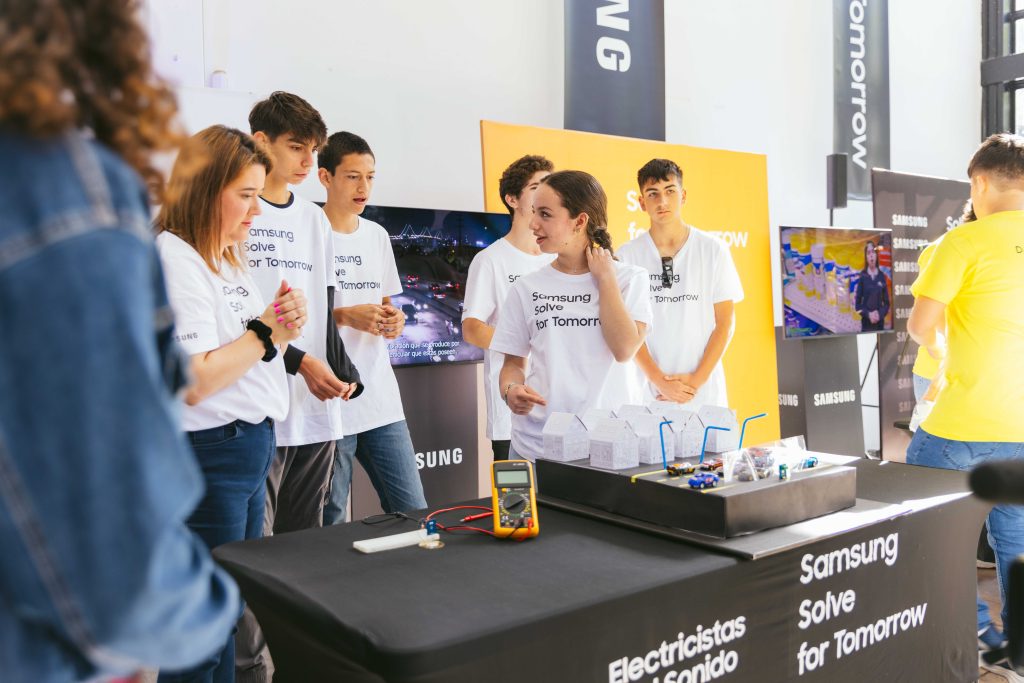A team of students from Chicureo, Santiago, in Chile, discovered a way to use the energy from the sound of cars on urban highways to generate light in areas with high crime rates. Kinetic energy was converted into electricity, stored in batteries, and powered by public lighting systems in nearby towns. The solution used the STEM approach (acronym for Science, Technology, Engineering, and Mathematics), seeking to improve the feeling of security in poorly lit areas. The project was a finalist for Solve for Tomorrow in the country, in 2023.
The participants were five students aged 15 and 16, in the second year of secondary education (the penultimate year of compulsory schooling) at Colegio San José de Chicureo. The school has been in pedagogical innovation for some years, based on Cooperative Learning, in which students work in a coordinated manner with each other to further their studies, says Catalina Carvallo, the project’s mediator teacher. “We started working with Visible Thinking Routines,” adds the Biology and Natural Sciences educator.
The starting point for “Electricistas del Sonido” (as the STEM project was called) was the “Scientific Project” classes, which begin in the fifth year of basic education when students are around 10 years old. “It is a methodology where work is done with collaboration, in teams of four to five randomly chosen students. The teachers form groups to encourage inclusion and with the concern that no one is left out,” Carvallo describes. There are two projects per semester and there is a team rotation.
“This particular team approached me with the decision to participate in the [Solve for Tomorrow] program and I think their initiative made a substantial difference in the outcome,” says the teacher. Initially, there were four students from the course group, but they were joined by another student from another course, whom they already knew.

Bibliographic review and previous experiences inspired the STEM project
Up to this point, they knew about the program and how it worked, but they didn’t know exactly what they were going to do. They were very keen and also drew on the 20 years of experience of the teacher, who participates in competitions, awards, and initiatives of this kind. For example, this was the third time she participated in Solve for Tomorrow. The first year her project reached the 40’s finalists. In the second year, they reached the 10 finalists and in 2023, they reached the Grand Final, among the top five.
The topics worked on by the other teams in the course were truly diverse; from food labels to reduce obesity rates to an application to fight fires. The “Electricistas del Sonido” team began to think about public safety. They observed that there are neighborhoods with a high incidence of assaults in Santiago, areas of urban highways. In addition to insecurity, these are areas with high noise pollution.
“We saw a lot of studies saying that the best way to increase safety is to have neighborhoods as well-lit as possible. So, we had the idea of giving a second use to this highway noise,” explains the teacher. She recalled a proposal made by other students that was rejected in the past: transforming sound energy into electricity.
There were few bibliographical references for such a project, so we had to figure out how to do it by trial and error. Everyone is afraid of making mistakes, but this is not a problem: it is an opportunity for improvement”, says the teacher.
The prototype was adapted to a smaller scale
With the help of the Physics and Music teachers, they identified what other materials they needed to make the prototype, such as cables, lights, a light bulb, a lithium battery, and capacitors. The team calculated that 500 piezoelectrics needed to be placed on every 1m² of the highway to generate enough energy to light up four to five 100V streetlight bulbs. The team bought the piezoelectrics online, with investment from the school itself. “But we couldn’t get enough piezoelectrics to make a larger project and we also had to think of something that wouldn’t put us at risk, which would be manageable for school students,” explains Carvallo.
So, they made an experimental prototype on a small scale, in which they managed to transform vibration into energy. The piezoelectrics were placed on real city highways and connected to a LED light (which generates light with little need for electrical energy). The idea was that the sensors would capture the vibrations, which are converted into electricity, and turn on the lights. They called this invention the “Sonic Illuminator.”
For the educator, the great advantage is that this source is constant, unlike solar energy, for example, which can only be supplied during the day. “It is an inspiring project, which can be used in large cities. It can be tested in a factory or airport, which makes noise all the time,” she believes.
Collaboration was key to the STEM project
Everyone involved in the project volunteered to learn something new to help. The teacher had to study more about fluid mechanics and other Physics topics. One student was tasked with learning how to use SketchUp software (used to create 3D models on the computer) to make the prototype mock-up. Others studied Physics in depth, searching for data on the Internet, and communication.
In the final stage, there was a moment that marked the teacher’s experience. “The whole team was working in the laboratory, doing many extra hours, and her classmates, who were not in the project, started to appear to help when we needed them the most. It was genuinely nice,” she said, excited. Now, students from other years of the Scientific Projects course are already interested in making proposals for Solve for Tomorrow.




